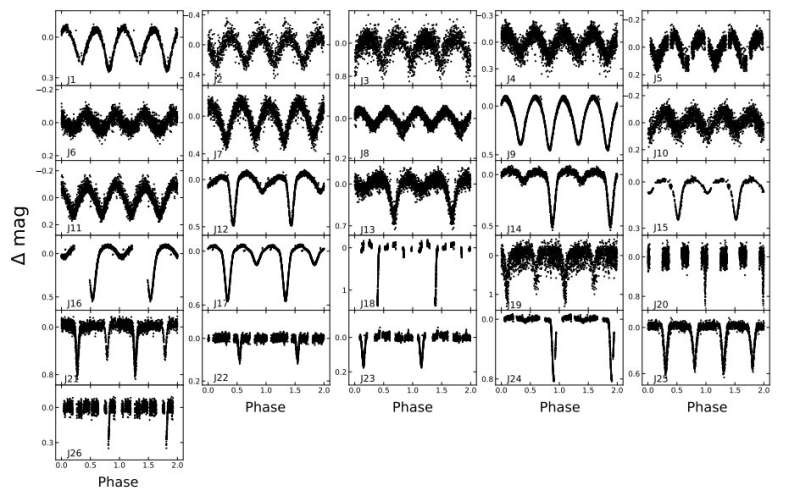June 21, 2022 report
Astronomers discover dozens of new variable stars

Using the Nanshan One-meter Wide-field Telescope (NOWT), astronomers from China have observed the open cluster NGC 2355 and its surrounding field, searching for variable stars. They have detected 72 new variables in this region. The finding is reported in a paper published June 14 on arXiv.org.
Star clusters offer excellent opportunities to study stellar evolution, as they are collections of stars with similar properties, for instance age, distance and initial composition. In particular, astronomers often search for variable stars in young clusters, which could be crucial to advancing the understanding of pre-main-sequence (PMS) stars, and therefore the initial phases of stellar evolution.
Recently, a team of astronomers led by Hong Wang of Xinjiang Astronomical Observatory in Xinjiang, China, carried out an extensive search for variable stars in NGC 2355 using NOWT's CCD camera. At a distance of some 5,400 light years, NGC 2355 is an open cluster in the constellation of Gemini, estimated to be 900 million years old. To date, only a few searchers for variables in this cluster have been conducted.
"We have investigated the variable stars in the field surrounding NGC 2355 based on the time-series photometric observation data. More than 3,000 CCD frames were obtained in the V band spread over 13 nights with the Nanshan One-meter Wide-field Telescope," the researchers wrote in the paper.
All in all, Wang's team detected 88 variable stars from 13 nights of photometric observations. It turned out that 72 of the 88 stars are new variables, while the remaining are known variables reported by previous observations.
The researchers classified the stars from the sample into different types based on their light curves and derived fundamental parameters. Finally, of the all stars reported in the paper, 52 are pulsating stars, 26 are eclipsing binaries, and four were classified as rotating variables. The remaining six are unclear type variable stars.
"For those variable stars for which no type has been determined, we may need more observations later to identify and classify these unknown variable stars," the astronomers wrote.
Out of the 52 pulsating stars, 38 were further classified as Delta Scuti variables, nine as RR Lyraes, three as Gamma Doradus variables, and two as Cepheid I type variable stars. When it comes to the 26 eclipsing binaries, 11 of them are of EW-type, nine of EA-type and the rest are of EB-type.
The researchers noted that four variable stars reported in the paper are members of NGC 2355, in addition to the 11 previously known variables classified as cluster members by a study conducted in 2018. They are located at the cluster's outer region and showcase homogeneity in space positions and kinematic properties with the cluster members. In addition, the authors of the study found that NGC 2355 has a metallicity of about -0.07 dex and a reddening at a level of 0.24.
More information: Hong Wang et al, Searching for Variable Stars in the Open Cluster NGC 2355 and Its Surrounding Region. arXiv:2206.06569v1 [astro-ph.SR], arxiv.org/abs/2206.06569
© 2022 Science X Network





















